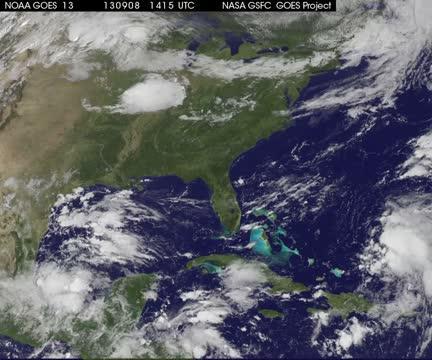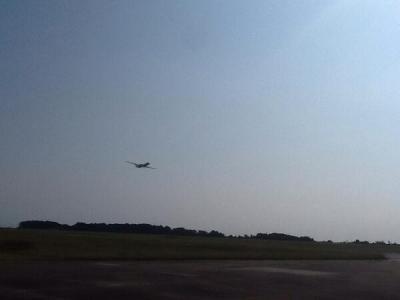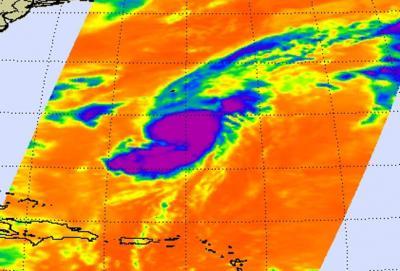After NASA's Aqua satellite passed overhead, NASA sent out an unmanned aircraft from the Hurricane and Severe Storms Sentinel or HS3 mission. HS3 features NASA's two remotely piloted Global Hawks. During the mission, both aircraft are being flown remotely from the HS3 mission base at NASA's Wallops Flight Facility in Wallops Island, Va. At 9:58 a.m. EDT today, Sept. 10, NASA's Global Hawk 871 took off to begin HS3 Science Flight number 7 to fly into Tropical Storm Gabrielle.
Another satellite was used to provide a look at the redevelopment of Gabrielle. NASA's GOES Project at the NASA Goddard Space Flight Center in Greenbelt, Md. created a 27 second video animation of imagery from NOAA's GOES-East satellite from Sept. 8 to 10 that shows Tropical Storm Gabrielle's resurrection. In the GOES satellite imagery, most of the clouds and showers are northeast of the center of circulation.

NOAA's GOES-East satellite captured a view of Tropical Storm Humberto (far right) and the remnants of tropical storm Gabrielle near the Bahamas on Sept. 9 at 7:45 a.m. EDT.
(Photo Credit: NASA GOES Project)
At 11 a.m. EDT/1500 UTC Gabrielle had maximum sustained winds are near 40 mph/65 kph and some strengthening is forecast during the next 48 hours, according to the National Hurricane Center. Gabrielle was located near latitude 30.6 north and longitude 65.0 west, about 120 miles/190 km south of Bermuda. Gabrielle is moving toward the north near 12 mph/19 kph and is expected to continue in that direction through tonight before turning northwest and slowing down. The National Hurricane Center noted that Gabrielle is expected to pass over or near Bermuda tonight and early Wednesday, Sept. 11.
At 11 a.m. EDT, sustained winds in Bermuda were from the southwest at 13 mph and are expected to pick up as Gabrielle comes closer. A tropical storm warning is in effect for Bermuda. According to the NHC, Gabrielle is expected to produce rainfall amounts of 3 to 5 inches over Bermuda with isolated maximum totals of 7 inches possible. Bermuda can expect storm surge of 2 to 3 feet above normal tide levels, and tropical-storm-force winds are expected to begin there tonight.

NASA's Global Hawk 871 departed from NASA's Wallops Island Flight Facility, Va., on Sept. 10 at 09:58 a.m. EDT for a 22-hour flight over reborn Tropical Storm Gabrielle in the Atlantic.
(Photo Credit: NASA)

NASA's Aqua satellite passed over the resurrected Tropical Storm Gabrielle on Sept. 10 at 0559 UTC/1:59 a.m. EDT and detected cloud-top temperatures of powerful thunderstorms (purple) that were colder than -63F/-52C.
(Photo Credit: NASA JPL/Ed Olsen)
Source: NASA/Goddard Space Flight Center